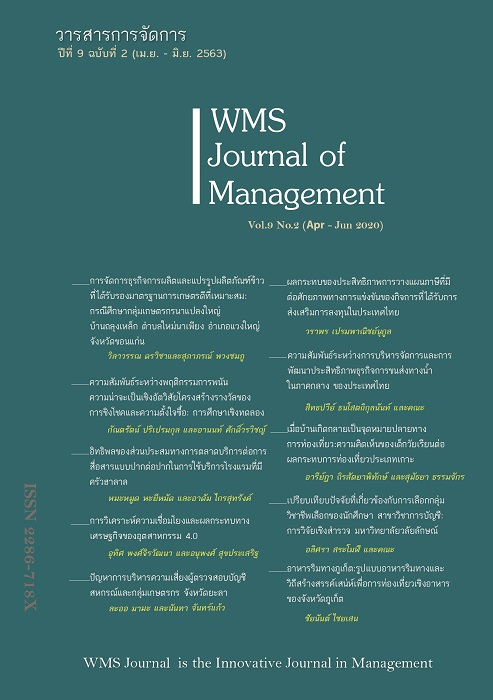Relationships between Gambling Behavior, Subjective Probability, Prize Structure of Sweepstakes and Willingness to Purchase: An Experimental Study
Main Article Content
Abstract
This completely randomized design (CRD) experimental research aims at investigating the effect of sweepstakes structure promotion on willingness to purchase where gambling behavior and subjective probability are covariates. Four types of sweepstakes structures are 1) grand prize only, 2) grand prize and many small prizes, 3) multiple large prizes, and 4) multiple large prizes and many small prizes where price discount with equal expected value as a control group. Five-hundred participants were randomly assigned to each condition. The results found that the multiple large prizes and many small prizes sweepstakes structure leads to highest willingness to purchase (47.1%). Education, monthly income and the interaction between sweepstakes
structures and gambling behavior are related to willingness to purchase such that low income participants with high gambling behavior tend to participate in sweepstake.
Article Details
References
kān phanan nai sangkhom Thai [Gambling in Thailand] Retrieved from http://www.gamblingstudyth.org/document_book/138/1/3/survey2558/
Chumchit, K., & Kittayapong, R. (2018). Legal Problems on the Consumer Protection a Case Study on Premium and Sweepstakes Promotion.Rajapark Journal, 12(25), 108-118.
De Finetti, B. (1964). Foresight: Its logical laws, its subjective sources. In H.E. Kyburg & H.E. Smokler (Eds.), Studies in subjective probability, New York, NY: Wiley.
Edwards, W. (1962). Utility, subjective probability, their interaction and variance preferences. Journal of Conflict Resolution, 6(1), 42-51.
French, S. (1986). Decision theory: An introduction to the mathematics of rationality. Chichester: Ellis Horwood.
Gupta, S. (1988). Impact of sales promotions on when, what, and how much to buy. Journal of Marketing research, 25(4), 342-355.
Iamsupasit, S. (2007). Theories and techniques in behavior modification (6th ed.). Bangkok: Chulalongkorn university press.
Ichitan group public company limited. (2015). 2014 annual report. Retrieved from http://market.sec.or.th/public/idisc/th/Viewmore/fsfull?searchSymbol=ICHI
Kahneman, D., & Tversky, A. (1972). Subjective probability: A judgment of representativeness. Cognitive psychology, 3(3), 430-454.
Kahneman, D., & Tversky, A. (1979). Prospect theory: An analysis of decision under risk. Econometrica, 47(2), 263-291.
Kalra, A., & Shi, M. (2010). Consumer value-maximizing sweepstakes and contests. Journal of Marketing Research, 47(2), 287-300.
Katumarn, P. (2007, May 21). rōk tit kān phanan [Pathological Gambling]. Retrieved from http://www.psyclin.co.th/new_page_6.htm
Matichon. (2019, May 24). Kō̜ng salāk trīam ʻō̜k lō̜ttō thop ngœ̄n rāngwan čhækphō̜t sō̜ng thao rāngwan thī nưng ʻāt tæ rō̜i lān! [The government lottery office pushes new Government to launch 600 million baht for the 1st prize.]. Retrieved from https://www.matichon.co.th/news-monitor/news_1507650
Lesieur H. R., & Blume S. B. (1987). The south oaks gambling screen (SOGS): A new instrument for the identification of pathological gamblers. American Journal of Psychiatry, 144(9), 1184-1188.
Narayana, C. L., & Raju, P. S. (1985). Gifts versus sweepstakes: Consumer choices and profiles. Journal of Advertising, 14(1), 50-53.
Peele, S. (2001). Is gambling an addiction like drug and alcohol addiction? Developing realistic and useful conceptions of compulsive gambling. Journal of Gambling Issues, (3), 1-10.
Pongsasithorn, A. (1999). Prevalence of Pathological Gambling among Employees of Nakornprathom Hospital. journal of the
psychiatric association of Thailand, 44(4), 308-319.
Quiggin, J. (1982). A theory of anticipated utility. Journal of Economic Behavior & Organization, 3(4), 323-343.
Rungruangpol, W. (2006). Principle of marketing. (4th ed.). Bangkok: Faculty of Commerce and Accountancy, Thammasat university.
Thiangtam, S. (2016). nǣothāng kamkap kān songsœ̄m kān khāi wādūai withīkān sīang chōk [Criteria for Sweepstake]. Retrieved from https://icgp.thainhf.org/wpcontent/uploads/2018/01/%E0%B8%A7%E0%B8%8814edit.pdf
Tversky, A., & Kahneman, D. (1992). Advances in prospect theory: Cumulative representation of uncertainty. Journal of Risk and uncertainty, 5(4), 297-323.


